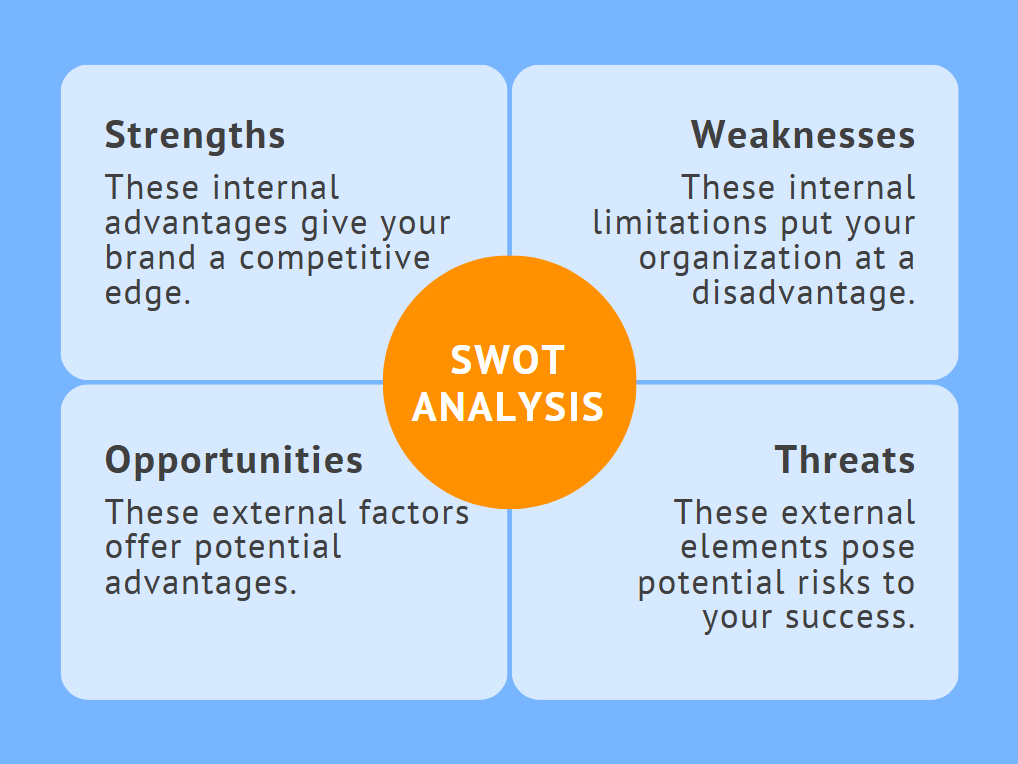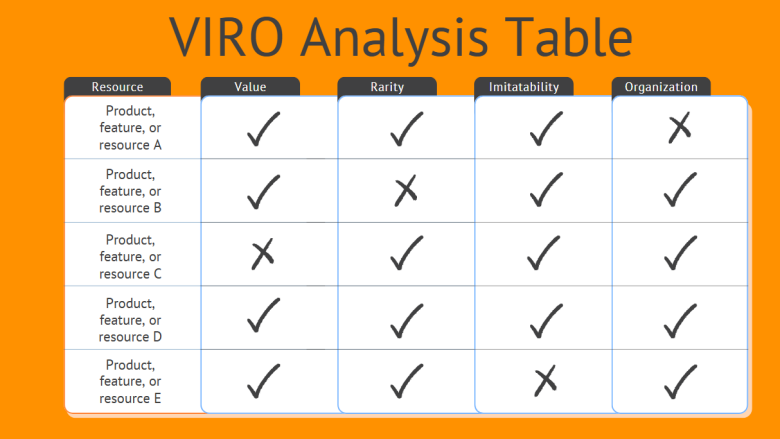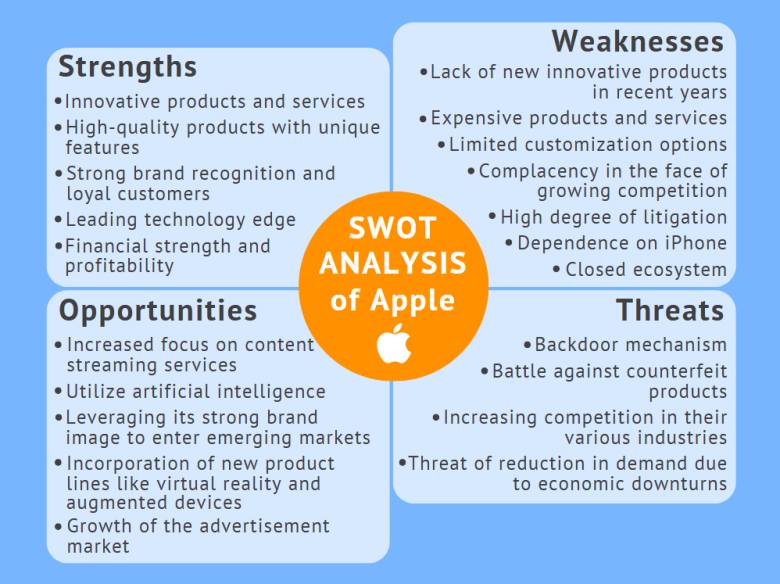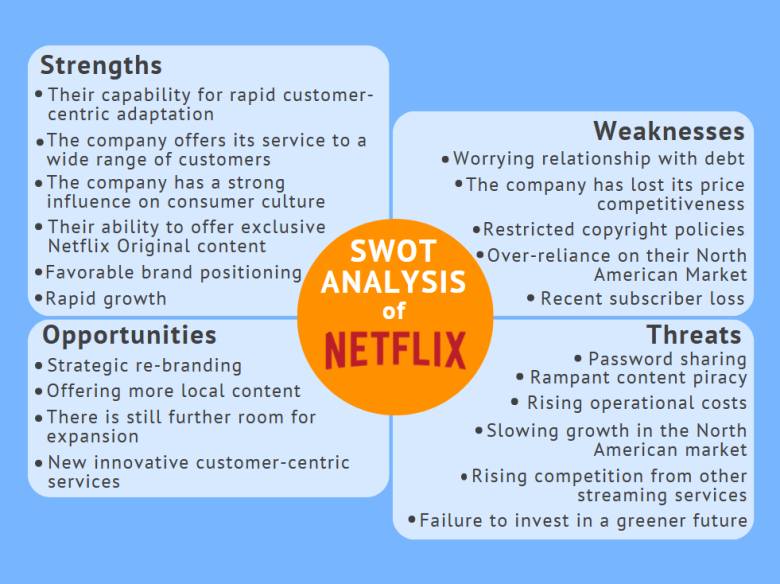How to Create a SWOT Analysis With Examples [+ Free AI Tool]
Quick Summary
- SWOT analysis clarifies your marketing strategy. It provides a structured approach to understand your position in the market, especially compared to competitors.
- The framework balances internal and external factors. By examining both what you control and what you don’t, you create a more complete strategic picture.
- A SWOT analysis helps you market faster, better, and cheaper. With a well-executed SWOT analysis, you’ll make decisions faster, cut costs by focusing resources where they matter, and boost your marketing impact.
- Regular updates keep your analysis relevant. Markets change quickly, making an annual SWOT review valuable for staying competitive.
- Our AI assistant streamlines the process. Answer a few quick questions about your business, and our tool drafts a complete SWOT analysis for you.
What is a SWOT analysis? Think of it as a GPS for your marketing team: It shows you where you are, where you can reasonably go, and the best path to get there. An honest assessment of your Strengths, Weaknesses, Opportunities, and Threats can cut through the clutter to help you make smarter, more strategic decisions.
It’s a simple framework—but when done right, it can reshape your entire marketing plan.
In this guide, we break down how to create a SWOT analysis that drives real results, with examples and a free AI tool to help you draft one in minutes.
How To Use Our SWOT Assistant
Just answer a few questions about your business or product, and our AI-powered assistant will draft a SWOT analysis for you. The more information you give it, the better your SWOT will be.
If you’re using Media Shower’s AI marketing platform, this task will be easier. Our platform already knows all about your company and business goals. Click here for a free trial.
Either way, keep refining your SWOT until you’re happy with the results.
What Is a SWOT Analysis?
A SWOT analysis is a deceptively simple framework that gives you a clear snapshot of your business. A SWOT examines four critical elements of your business position: Strengths, Weaknesses, Opportunities, and Threats.
This framework gives marketing teams a structured way to evaluate their current standing and inform strategic decisions.
The traditional SWOT framework uses four simple quadrants:

What does each element include?
- Strengths. These internal advantages give your brand a competitive edge. Identify them through benchmarking, subject matter expert insights, and VRIO analysis (see Strategic Frameworks below).
- Weaknesses. These internal limitations put your organization at a disadvantage. They might include insufficient expertise, limited resources, or operational inefficiencies that a VRIO analysis can help uncover.
- Opportunities. These external factors offer potential advantages. Discover them through competitor analysis, market trend monitoring, and PESTEL analysis (see Strategic Frameworks below).
- Threats. These external elements pose potential risks to your success. They might include economic downturns, new legislation, or shifting customer preferences.
Optional: Many marketers organize SWOT analyses into a grid that separates internal factors (strengths and weaknesses) from external ones (opportunities and threats).

Why Do Marketers Need a SWOT Analysis?
A SWOT analysis serves multiple purposes for marketing teams, especially those looking to develop or refine their strategy.
The analysis helps with:
- Strategic planning. SWOT provides a quick assessment of company strategy and direction—particularly valuable if you’re new to a company or role.
- Opportunity identification. The framework reveals market trends and potential areas for expansion before competitors capitalize on them.
- Change management. Understanding your position helps you adapt to market shifts and prepare for external challenges.
- Market positioning review. SWOT clarifies where your brand stands with consumers and competitors in your vertical.
- Resource optimization. The analysis guides more accurate budget allocation by highlighting where your brand excels and where it needs improvement.

What Are Best Practices for a Strategic SWOT Analysis?
Creating a useful SWOT analysis requires thoughtful preparation and execution. The most effective analyses follow these best practices:
- Be realistic and specific. Ground each point in observable facts rather than generalizations. For example, instead of listing “strong brand,” cite specific indicators such as customer satisfaction scores, referral rates, or Net Promoter Scores.
- Focus on the present and future. Anchor your analysis in the current business landscape, while accounting for potential developments. Consider how emerging trends, competitor moves, or regulatory changes may influence your position.
- Get stakeholder input. Involve team members from various departments to capture a wider range of insights. Diverse perspectives improve the accuracy of your analysis and foster organizational alignment.
- Prioritize clarity over completeness. Limit your analysis to the most impactful strengths, weaknesses, opportunities, and threats. A focused framework drives more effective strategy development than an exhaustive list.
- Distinguish internal from external factors. Clearly separate strengths and weaknesses (which reflect internal capabilities) from opportunities and threats (which are shaped by the external environment).
- Analyze interdependencies. Look beyond individual entries to uncover patterns. For instance, assess how specific strengths might be used to address threats, or how a weakness could block an opportunity.
- Use action-oriented phrasing. Frame each point in a way that suggests a possible response. For example, “limited digital reach constrains campaign effectiveness” points to a need for expanded digital investment.
- Update periodically. Revisit your SWOT at regular intervals—such as annually or after major strategic shifts—to ensure its continued relevance and accuracy.
- Link directly to strategic planning. Use insights from your SWOT to inform concrete actions. Each element should guide decisions that align with your organization’s goals and capabilities.

How Do Strategic Planning Frameworks Strengthen a SWOT Analysis?
A SWOT analysis gives you a solid foundation, but strategic marketers know that complementary frameworks turn good analysis into great strategy.
These frameworks address SWOT’s limitations while providing deeper insights into specific areas of your business environment. Two powerful approaches—VRIO and PESTEL—can help you turn your basic quadrants into a precise action plan.
How does VRIO analysis strengthen a SWOT?
The VRIO framework evaluates your resources and capabilities based on four criteria:
- Value: Does the resource provide economic value to your company?
- Rarity: Is the resource difficult for competitors to obtain?
- Imitability: Is the resource expensive or complicated for competitors to imitate?
- Organization: Is your company organized to capture the resource’s value?

VRIO analysis helps you determine which strengths are truly sustainable competitive advantages and which weaknesses need immediate attention.
For example, a proprietary technology that meets all VRIO criteria represents a stronger advantage than one that competitors can easily replicate.
How does PESTEL analysis improve your SWOT?
PESTEL (or PESTLE, also correct though less common) examines six external factors that impact your business environment:
- Political: Government policies, regulations, and stability
- Economic: Economic growth, inflation rates, and consumer spending patterns
- Social: Cultural trends, demographic shifts, and social attitudes
- Technological: Innovations, automation, and digital transformation
- Environmental: Climate concerns, sustainability initiatives, and resource scarcity
- Legal: Industry-specific laws, compliance requirements, and potential litigation

This framework helps you identify overlooked opportunities and threats for your SWOT analysis. For instance, a PESTEL analysis might reveal an upcoming regulatory change that creates a market opportunity your competitors haven’t noticed.
How Do Top Companies Use SWOT Analyses?
Let’s look at two SWOT analysis examples for major companies as analyzed by Business Model Analyst, along with the insights they unlock.
Apple’s SWOT analysis

Key Insights
Strengths
• Brand loyalty: Apple users aren’t just customers, they’re evangelists.
• Design excellence: Sleek, simple, intuitive.
• Vertical integration: Apple controls both hardware and software, ensuring quality.
Weaknesses
• High prices: Premium design comes at a premium cost.
• Closed ecosystem: You’re in Apple’s world now, which can be limiting for users.
• Dependence on flagship products: A dip in iPhone sales = major impact.
Opportunities
- Emerging markets: Brand strength positions Apple to win new customers in high-growth regions.
• AR/VR innovation: Virtual and augmented reality offer fresh frontiers for product expansion.
• Streaming growth: Original content and services like Apple TV+ can drive deeper user engagement.
• AI integration: Smarter features and automation can enhance products and user experiences.
• Digital advertising: Expanding into ad services opens up a high-margin revenue stream.
Threats
• Counterfeit risk: Knockoff products dilute brand value and cut into revenue.
• Fierce competition: Tech giants and low-cost challengers are crowding every category.
• Economic slowdowns: Premium pricing makes Apple more vulnerable during downturns.
• Security concerns: Backdoor mechanisms could erode user trust and invite regulatory scrutiny.
Key takeaway: Apple’s brand strength is legendary, but it comes with a price tag—literally. Apple recognized its pricing vulnerability and has leaned into lower-cost options like the iPhone SE to reach new markets.
Netflix’s SWOT analysis

Insights
Strengths
• Original content powerhouse: Hits like Stranger Things and The Crown.
• Global reach: Available in over 190 countries.
• Strong user data: Netflix knows what you like before you do.
Weaknesses
• Rising content costs: Original shows aren’t cheap.
• Subscriber fatigue: More competition = more churn.
• Dependence on hit shows: One flop can sting.
Opportunities
• Gaming and interactive media: Think Bandersnatch.
• Partnerships: Bundling with telcos or streaming services.
• Emerging markets: Growth potential in Asia and Africa.
Threats
• Streaming wars: Disney+, Amazon Prime, HBO Max = serious rivals.
• Password sharing: Still a big issue.
• Regulation risk: Especially in foreign markets.
Key takeaway: Netflix spotted early threats like competition and churn. They began exploring ways to keep users engaged beyond binge-watching, doubled down on content, and diversified into games.
Next Steps: How Do I Turn A SWOT Analysis Into Strategy?
Savvy marketing teams use SWOT as a starting point. The real power lies in what you do next.
A TOWS matrix (yes, that’s SWOT spelled backward) is an effective next step that helps you match internal and external factors to develop strategies.
Here’s what a TOWS matrix might look like:
Example: Netflix’s opportunity is expansion into gaming, and its strength is engaging content, an SO strategy might be: Use storytelling skills to create original interactive games.
Here are other effective ways to translate your SWOT insights into marketing strategy. (And remember: AI can help with all of these steps.)
1. Prioritize with an impact matrix.
Once you’ve listed key SWOT items, assess them based on two factors: potential impact and level of control. Focus on high-impact, high-control items first—these are the changes your team can actually make, with a payoff that matters.
2. Build SMART goals around SWOT findings.
Use the insights to develop specific, measurable, achievable, relevant, and time-bound goals. For example: “Increase brand visibility in emerging markets (opportunity) by launching a regional ad campaign by Q3.”
3. Develop customer-focused playbooks.
Turn your strengths into repeatable best practices. If “high customer satisfaction” is a strength, create onboarding and support templates that amplify this advantage across channels.
4. Conduct scenario planning around threats.
Pick your top threats and run “what-if” planning sessions. How would your team respond to a supply chain breakdown? A new competitor? A major regulation change? This shifts SWOT from static insight to strategic foresight.
5. Align marketing initiatives to business objectives.
Map SWOT takeaways directly to your organization’s strategic goals. If the company’s objective is to reduce dependence on one product line (weakness), build a campaign to spotlight under-leveraged offerings or services.
6. Communicate your findings organization-wide.
Summarize the key points from your SWOT analysis and share them with leadership, product, and customer-facing teams. This alignment increases visibility and ensures your strategy is grounded in shared insights.
Turn Analysis Into Action
Whichever strategic path you choose, a SWOT framework is only as powerful as the steps that follow it.
The good news: AI can support each phase of the process, from identifying insights to generating strategies and setting priorities. With the right tools, you can move from insight to execution faster and with greater clarity.
To learn more about SWOT analysis, read our FAQ below.

Marketer Takeaways
- Start with structure. Set up a four‑quadrant grid to frame your analysis.
- Cover all angles. Include both internal and external factors in your review.
- Use strategic tools. Apply benchmarking, VRIO, and PESTEL to deepen your insights.
- Keep it up to date. Review and update your SWOT at least once a year.
- Involve your team. Invite stakeholders to collaborate and catch blind spots.
- Turn insights into actions. Identify clear next steps from each SWOT finding.
- Leverage AI tools. Draft and refine your SWOT quickly with AI assistance.
Media Shower’s AI marketing platform helps you generate data-backed SWOT analyses in minutes—for sharper insights you can act on fast. Click here for a free trial.
FAQ: Advanced Tips for Using SWOT Analysis in Marketing
Why is SWOT analysis important in marketing?
It helps marketing teams align strategy with reality. By identifying what’s working, what’s not, and what’s changing externally, marketers can make better decisions about campaigns, messaging, product focus, and resource allocation.
How do I conduct a SWOT analysis?
Start by gathering both qualitative and quantitative data. Internally, examine reports, team feedback, and performance metrics. Externally, analyze industry trends, customer behavior, and competitor activity. Engage cross-functional stakeholders to build a fuller picture.
How many items should I include in each category?
Limit your list to the top 3–5 points per quadrant. Focus on insights with real impact, not a complete inventory of every possible factor. A concise SWOT analysis is more strategic and easier to act on.
What tools help improve SWOT analysis accuracy?
Use frameworks like VRIO (to assess internal strengths) and PESTEL (to evaluate external trends). CRM data, survey tools, and customer feedback platforms can also ground your SWOT in hard data rather than opinion.
What’s the difference between a SWOT and a TOWS analysis?
SWOT identifies where you stand; TOWS helps determine what to do next. A TOWS matrix takes the findings from your SWOT and pairs internal and external factors to develop concrete strategic actions.
What is the difference between SWOT and PESTEL in strategic planning?
SWOT includes both internal and external analysis. PESTEL focuses strictly on external forces—Political, Economic, Social, Technological, Environmental, and Legal. Use PESTEL to dive deeper into trends and risks affecting your industry.
What’s the difference between SWOT and VRIO?
SWOT gives a big-picture view of your current position. VRIO (Value, Rarity, Imitability, Organization) helps identify which internal resources offer long-term competitive advantage. They’re complementary tools: use SWOT to assess landscape, VRIO to test durability.
How do I prioritize findings in a SWOT analysis?
Use an impact-control matrix to evaluate which items are both high-impact and within your control. Focus first on those. You can also assign scores for urgency or business value to prioritize your strategic responses.
How do I link SWOT analysis to my marketing goals?
Translate each SWOT insight into a SMART goal. For example: If “low brand awareness” is a weakness, a goal might be: “Increase website traffic by 30% over six months through organic search.”
Can SWOT analysis be used for product marketing?
Yes. SWOT is especially useful when launching or repositioning products. Focus on how your product’s strengths meet market needs, while addressing any competitive threats or feature gaps.
Can SWOT analysis be used for competitive benchmarking?
Absolutely. Conducting a competitive SWOT helps you map your position relative to key rivals. It’s particularly useful when entering a new market or responding to emerging competition.
How can a SWOT analysis help a company explore new markets or launch a new product?
It highlights internal capabilities and external opportunities that can inform go-to-market strategy. For example, a strong brand reputation (strength) aligned with an underserved demographic (opportunity) might guide expansion plans.
What industries benefit most from regular SWOT analysis?
Industries that experience rapid change—like tech, media, healthcare, and finance—benefit most. That said, any organization undergoing growth, facing disruption, or entering new markets should revisit SWOT regularly.
How often should I update my SWOT analysis?
At minimum, review your SWOT annually. For fast-moving industries or during times of change, consider quarterly reviews to keep your strategy relevant.
What are common mistakes in SWOT analysis?
The biggest pitfalls include being too vague, mixing up internal and external factors, listing outdated information, or failing to act on the findings. A good SWOT is clear, current, and tied to strategy.
Can AI help with SWOT analysis?
Yes. AI tools—like Media Shower’s AI marketing platform—can analyze customer data, market trends, and competitive intelligence to suggest draft SWOT entries. This makes the process faster, more accurate, and easier to turn into strategy.
How can I automate a SWOT analysis with AI?
AI SWOT tools like Media Shower’s assistant use your inputs—like company goals, market position, and competitive benchmarks—to draft a complete SWOT analysis. These tools can also integrate with business intelligence platforms, helping you keep your analysis current and contextual.
Media Shower’s AI marketing platform helps you go from SWOT to strategy . . . fast. Click here for a free trial.


